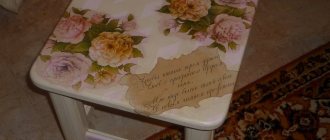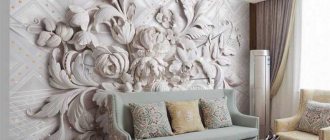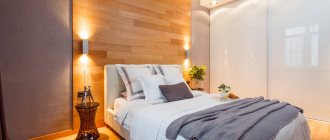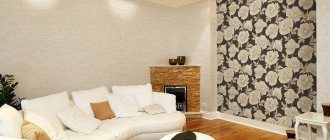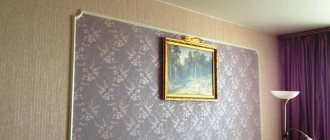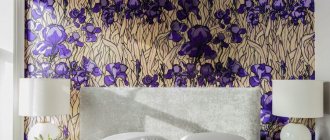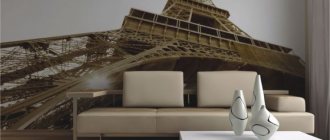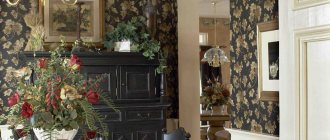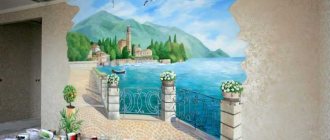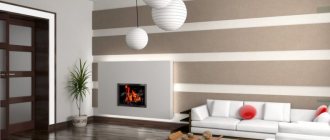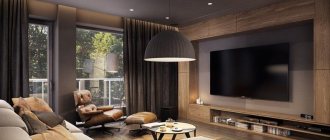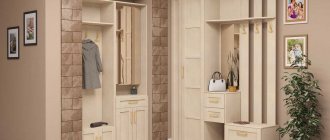There is no need to throw away the remains of old wallpaper - you can use them to make an original panel.
Numerous remains of multi-colored and even differently textured building materials can easily be used to create a wallpaper panel for the wall, a photo of which will then be taken by pleasantly surprised relatives and friends. Pieces of any size are suitable for work. The main thing is to combine them correctly. It is not necessary to maintain symmetry. It is enough to correlate them harmoniously.
How to decorate the walls: photographs and drawings
If you have a happy family, then a suitcase with photographs is definitely hidden in your bins.
The next answer to the question of how to decorate the walls of a room will be compositions from photographs. By choosing original photo frames in the same style, you can decorate a photo panel on the wall, presenting the whole story of your life.
Creating a photo collage is not at all difficult. Note that family photos are perfect for the living room and bedroom, and in the kitchen you can decorate the wall with photo compositions of captured fruits, vegetables, spices, adding a bright accent to your interior.
Also, beautiful wall decor from photographs can be complemented with children's drawings
Such originally designed walls always attract the attention of guests and delight the household for a long time with positive emotions about the past time.
DIY wall decor ideas, 65 photos
If you want to change something in the design of your rooms, wall decoration is a good chance to add personality to the interior and show your creativity. Today in any store you can find various finishing materials, such as photo wallpaper, paint, decorative plaster, wall panels and much more. You can also decorate the walls manually.
Below we will present you a selection of ideas that will help you get inspired to create your masterpieces.
Horizontal stripes on the walls will visually expand the room and emphasize the overall style
Before you start painting the walls, arm yourself with chalk or a simple pencil, a construction tape and a level. Choose two different shades, one of which will be the base. It should be lighter than the other color. If you are going to paint a wall with stripes of the same color, but with different textures (glossy and matte), you need to use matte as the base paint. An alternative to stripes can be stencils, with which you can create an original composition.
DIY patterns on the wall
You can also use fabric, napkin, sponge or putty to create unique textures. You just have to use your imagination and you can create a real masterpiece!
Original DIY wall decor ideas
Using a stencil is considered the most convenient for applying an image. It can be made of plastic, cardboard, plywood or paper. The main thing is to skillfully choose a design and style. Before you start painting, prepare the wall. It must be perfectly clean, free of dust and dirt. Then attach the template as tightly as possible
This is very important, because if the stencil does not adhere sufficiently to the wall, paint may leak under it. At the end, leave the filled template until completely dry and remove the stencil.
Unusual wall decor in the living room
Due to its simplicity, the use of design blanks has become the most common. Wallpaper is often purchased for this purpose. Nowadays it won’t be difficult to find wallpaper with a ready-made pattern. Recently, photo wallpapers have been in demand. In this case, you will get real paintings, landscapes and create a panorama of your favorite city in the room.
Original wall decor ideas
Triangles are a current trend in art. When choosing this wall design, use soft pastel colors, limiting yourself to a small number of colors. It is best to use a geometric pattern on one wall. You can create entire patterns from geometric shapes. Just pick just two brighter and more saturated colors and start painting.
Wall decor with wallpaper in a children's room
One of the available ways to add variety to the interior is to decorate the walls with wallpaper. Quite often, unusual and original wall design is achieved by combining different textures and colors.
You can use stickers to decorate a children's room. They can always be removed without damaging the wall covering and replaced with new ones. Children really love bright stickers with characters from fairy tales, cartoons or TV series. Graceful butterflies on the wall for decoration will also look great.
Decorating walls is a great way to show creativity, good taste and create a truly unique apartment interior.
Creation technology
How to make a decorative panel on the wall of a living room or kitchen? First of all, a frame made of baguette is glued to the wall, which will indicate the boundaries of the future work. In the catalog you can choose a beautiful wooden or polyurethane foam baguette. This structural element can be decorated with a pattern, painted or requiring painting. If you plan to use wallpaper and wall panels in a marine style, the frame can be made of rough rope.
Having fixed the frame on the wall, we move on to markings. The ideal option is marking in squares. This way it will be immediately clear where and what element needs to be glued. Using similar markings, you should cut the wallpaper. In order not to lose the sequence, you can put the elements into a single picture and number each of them. After gluing the pieces to the wall, carefully trim the edges if necessary.
What's next
The next operation is actually gluing the wallpaper and framing. However, when figuring out how to highlight photo wallpaper on a wall with a frame, you can find two options:
- The canvas of the painting is glued first, and then the frame is attached
- First, the frame is mounted, and only then the wallpaper is pasted.
Which method to choose is up to you, since there are no fundamental differences between them. The only case where the order of gluing matters is when using ready-made frames. In such a situation, you will have to be guided by the dimensions of the frame and it is better to install it first.
Types of decorative panels
There are several varieties.
Tile
With the help of this decorative decoration, it is possible to significantly dilute and diversify the atmosphere in the room, making it especially beautiful.
From wallpaper
Using sections of wallpaper you can easily create an unusual accent on the wall and give the room an attractive, fresh and updated look.
Foamiran
Thanks to such a picturesque panel on the wall, combining graceful elegance and beauty, it turns out to harmoniously complement almost any interior.
From paper
It is an affordable and simplest, but at the same time very stylish and original solution for decorating a space. Paper is a fairly malleable material and has a number of techniques for creating wall compositions, such as quilling or scrapbooking.
Plaster
They are a very impressive and expensive wall decoration, which personifies high culture and a sign of excellent taste.
The photo shows a small rectangular plaster panel located above the bed in the bedroom.
Traffic jams
Wine corks can have different looks and shapes; with their help, you can create very stylish, both round and square panels that fit wonderfully into any interior design.
From fabric
This simple and at first glance unremarkable wall decor can become a real work of art, decorating the space and ideally matching the style of the room.
Leather
A leather composition can be easily created from various scraps or old leather products and accessories. This design is considered original and has a very impressive and aesthetically attractive appearance.
Metal
A metal installation opens up a huge variety of decorative possibilities and allows you to add some zest to the interior, giving it an originality.
From threads and nails
Using the string art technique, which involves creating compositions using threads and nails, you can achieve a unique and extraordinary wall design, creating a non-boring and non-trivial design.
Food
A variety of products are used for such compositions, such as cereals, coffee beans, dried fruits or vegetables, spices and much more. This decor is especially relevant for the kitchen space.
Light
Thanks to such an original and bright accessory, with light elements located over the entire surface or fragmentarily, you can create the main accent on the wall in the room.
Shells
The panel made of shells has a truly mesmerizing appearance and combines simplicity, unpretentiousness and mystical beauty, which makes you want to look at it for a long time.
Stones
Due to the unusual texture, color and interesting pattern of onyx, marble or other stones, it is possible to set the tone and mood of the entire interior and create a bright accent in the space.
Moss
Mossy decorations represent an evergreen beautiful picture, undoubtedly becoming a true interior find.
The photo shows a panel made of stabilized moss, decorated with a black frame.
Flowers
Dried flowers, such as marigolds, asters, roses or poppies, which perfectly retain their natural shape after drying, are often used to create decorative panels that can give a room a certain imagery.
Cones
They are an environmentally friendly, amazing and beneficial natural material that has a spectacular and stylish look and allows you to get very beautiful wall decor.
Leaves
Thanks to the natural warmth and naturalness of the leaves, they add brightness, positivity and special naturalness to the room.
Bamboo
This decor is unusual, original and at the same time uncomplicated and simple. Due to the wood structure and warm color, the furnishings are filled with exquisite exotic motifs.
Tree cuts
They have an interesting, stunning and as if created by nature, appearance, which allows you to further emphasize the individuality of the style.
Tree branches
With the help of such accessible material, it is possible to create a light composition or a modern and unusual installation on the wall.
Advantages of wallpaper panels
Panel in the living room interior
The positive aspects of using this material include:
- a wide variety of options - today you can purchase panels that differ in the production material, the principle of applying the image, theme, color design and other characteristics, users only have to choose a product that meets specific needs;
- environmental friendliness - only safe raw materials are used in the production process, which do not emit toxic substances into the atmosphere even when heated, so the products can safely be used in a children's room or bedroom;
- durability - the material does not fade in the sun, has sufficient abrasion resistance, moisture resistance and many other positive aspects, due to which it can maintain its magnificent appearance for a long time;
- ease of installation - the panel does not require adjusting to size or cutting; it is produced in ready-made sizes, which can only be carefully glued to the wall or ceiling. The only difficulty that you may encounter when gluing is the joining of the parts that make up the panel; the number of elements can be from 1 to 16, depending on the size of the finished product;
- ease of care - caring for the surface of the panel is as simple as possible, just remove the dust in time, and if necessary, wipe the product with a slightly damp cloth. In case of severe contamination, such products can be washed in the same way as non-woven or vinyl wallpaper;
- exclusivity of the finished interior - the product can be glued to the entire wall, to part of it or to the ceiling, thereby creating a unique look for the room; in addition, due to the variety of appearance, you can always create a unique and inimitable interior in your home.
Wallpaper for the bedroom
In general, panels can be classified not just as finishing materials, but as some kind of art. After all, this decorative element is used to decorate the space. However, it should be borne in mind that such a product differs from paintings or photo wallpapers, since here, most often, there is no artistic image or landscape. The image represents ornaments, patterns or geometric shapes. Of course, nature, animals, human figures, and so on can be depicted here, but such an element is not an independent type of creativity. It requires a permanent place, for which it is created. This means that the panel is not intended for frequent changes of location, and if you still get tired of the product, it will have to be removed and disposed of or replaced with another.
Applications of patchwork
With this option, the panel consists of many different pieces of wallpaper with different patterns, ornaments, and in a variety of colors. The decorated wall is an image consisting of small-sized cut “pieces” (the shape is usually square, rectangular or diamond-shaped).
The patchwork design is ideal for decorating a children's room, as well as for rooms in a vintage or retro style. However, when selecting a composition, you should choose no more than 3 combinations of patterns or shades of images.
Fragments of wallpaper are glued in a random order, one next to the other or overlapping, so that the resulting image resembles a patchwork quilt. Important tips: for patchwork it is better to choose wallpaper of the same density, and you need to glue them as tightly as possible so that the edges do not come off.
Techniques for making panels
Quilling, floristry, patchwork, decoupage, appliqué, mosaic, macrame, embossing - there are many techniques in which you can make a panel with your own hands. Briefly about some of them.
Decoupage
– when you place an image on the base and decorate it with three-dimensional details. For example, a photo frame is covered with fabric onto which a photograph or a picture printed on a printer is glued. Then it is decorated with beads, ribbons, shells or other elements, depending on the style of the panel.
Quilling
- twisting narrow strips of paper and forming fancy patterns out of them. That is, the paper is cut into strips of the same width. Then each is tightly rolled into a tube. Unwinding the tubes in a certain way, we lay out an openwork pattern from the resulting curls. It is necessary to fix the curls among themselves.
Mosaic
It is good to use as a technique for creating panels from glass shards, pieces of colored plastic, wine corks, planks, buttons and other materials. Laying out fantastic or simple patterns requires a certain skill, a solid base and an impressive adhesive composition, but it looks simply amazing on the kitchen wall.
Patchwork
is a new name for the good old patchwork. Mosaic made from patches of various shapes. To make panels, scraps of leather, fabric of various textures and paper, connected to each other using threads, buttons, paper clips, fishing line or yarn, look impressive. An excellent frame made of flaps would be a frame made of wood or plaster.
Let's look at a few ideas on how to make a beautiful panel on the wall with your own hands, which will push you to create your own unique masterpiece.
How to glue a canvas or modular composition - description, photo of the result
From simple
Ordinary wallpaper on any base from vinyl to non-woven is the most common material for creating paintings and decorative panels (read about the features of gluing vinyl wallpaper here, and from this article you will learn how to properly glue wallpaper on a non-woven basis). The work consists of several stages:
- Cut out the cardboard base to the required size.
- We cover it with basic wallpaper. They can be either plain or have a special texture and pattern (how to economically glue wallpaper with a pattern?).
- Using a stationery knife or thin scissors, we cut out various elements from the available scraps: flowers, geometric shapes, patterns, ornaments.
- We evenly saturate the inside of the cut out elements with PVA glue and glue the parts onto the prepared base according to your sketch.
- Use a frame for final decoration. It will allow the work to last longer and give it a finished look.
When working, it is better to use wallpaper of the same type and thickness. This will allow you to harmonize the elements according to texture.
Important Modular paintings made from wallpaper from the same line look very impressive. These wallpapers usually have the same pattern, but differ in color
By collecting a number of such shades, you get an unusual design solution for decorating a bedroom or living room (read about how to choose the right wallpaper for a bedroom here, and from this article you will learn how to beautifully and stylishly hang wallpaper in this room).
Another interesting option is to create a modular system of wallpaper of the same color or even monochrome, but with different geometric, floral or animal patterns. Prints in the same color will combine and create a unique, mesmerizing effect.
From liquid
This new finishing material is just entering the arsenal of our compatriots and is gradually gaining popularity. Liquid wallpaper is perfect for creating a picture, moreover, a three-dimensional image.
A picture of liquid wallpaper is made directly on the wall. It is first necessary to determine which image will harmoniously combine with the furniture and color scheme of the room.
A picture made from liquid wallpaper cannot be simply removed and pushed behind the closet.
The work is reminiscent of classical drawing. The material is diluted, laid out in several containers, each with its own color added. A sketch is first applied to the wall, which is then “painted over” by applying liquid wallpaper (we talked about how to properly dilute them and apply liquid wallpaper in a separate article).
A huge advantage of liquid wallpaper is the ability to create any layer thickness. Thus, with some skill and dexterity, you can create a three-dimensional image. But be careful: a thick layer takes a long time to dry - up to 2 days.
From photo wallpapers
Photo wallpaper is the easiest way to create an interior picture. Firstly, they can be glued directly to a plain base and cover most of the wall with them. Secondly, using a little ingenuity, you can create an effective modular picture in a frame with a landscape, a view of a metropolis or an abstraction that you like (read about how to choose the right photo wallpaper for the living room and other rooms and combine it with the interior, and we talked about how to hang photo wallpaper separate article).
Attention Please note that you cannot stretch photo wallpaper onto a stretcher. This process “eats” part of the picture at the folds, and as a result the image will be broken
It is best to use cardboard as a base.
The process of creating a picture from photo wallpaper will not take much time:
- Lay out the photo wallpaper on a flat surface.
- Choose the number and sizes of modules. There may be three vertical ones, or there may be nine, arranged asymmetrically in several rows.
- The bases of all modules are cut out of thick art cardboard.
- Photo wallpapers are cut into pieces equal to the bases and glued to them. We recommend applying PVA glue evenly over the entire surface of the wallpaper to avoid the appearance of wavy lines.
- Each element is framed.
- Frames with painting elements are hung in the required order, and an equal distance between the modules must be maintained.
Decorating a room with molding
A frame for photo wallpaper on the wall is one of the most interesting design solutions for home decoration. A few years ago, only dull and inexpressive paintings could be found on sale, but nowadays the situation has changed dramatically. The construction market offers a large number of bright options for every taste, so each user can choose the most suitable product.
Photo wallpapers can become an expressive accent and add originality to your home. The modern manufacturing method assumes the wear resistance and durability of this material. For a painting to look beautiful on the wall and attract everyone’s attention, it is not enough just to stick it on. It is also necessary to take care of the appropriate decor for the image and frame it in a suitable frame.
Kitchen with photo wallpaper Source design-homes.ru
Selection of performance technique
Most often, designers design a picture in two main ways:
- The easiest way is to frame the entire image at once;
- A more interesting method involves creating a driptych or triptych - sticking several sections of a painting in a certain shape and sequence.
Each method has its own advantages and is suitable for decorating a specific type of interior.
White wall with photo wallpaper Source newwalls.as-creation.com
Selection of technology
When choosing a frame for photo wallpaper, you need to decide on the further use of the picture. You can order printing of image details that fit a specific frame or cut out elements from a large canvas. Next you need to do the following:
- The first stage of work consists of cutting and preparing the necessary parts from the whole canvas.
- Marking the location of the future placement of paintings and deciding on the method of their arrangement.
- Installation of frames on the prepared surface. This action depends on the purchased material - it can be gluing the frame, puttying and painting the stucco, or decorating any other suitable base.
- At the last stage, the details of the photo wallpaper are glued inside pre-fixed frames.
Expanding space with photo wallpaper Source design-homes.ru
Color selection
Interesting solutions for color design of frames:
- Contrasting combination of white planks and dark wall. For better effect, transitions to the ceiling, window and door openings, furniture contours and other noticeable interior details are finished in the same way. In this way you can visually expand the space and add light to it.
- White or light planks on pastel walls. This solution looks good in large rooms, such as a living room. The shade is suitable for decorating walls, paintings and mirrors, as a result the room looks more sophisticated and sophisticated.
- Multi-colored planks are often used for children's rooms and hallways; they can also be used to create a bright accent or highlight certain items. For the same purpose, choose contrasting strips or several shades darker than the main shade.
Living room with photo wallpaper Source krovli-zabori.ru
A specific color scheme is chosen based on the overall tone of the interior and the tasks facing the designer.
Coffee on photo wallpaper Source kit4en.ru
Framing
Before you start creating your own masterpiece, you should decide whether this object will be framed in a baguette or left in free flight. To do this, it is necessary to take into account all the features of the interior. Many decorators believe that unframed paintings are best placed on plain surfaces, but for patterned walls it is necessary to enclose the composition in a limited space. The material for frames can be very different - plastic, metal, wood, plaster. There can be many options.
Wood is considered a universal option and fits almost any style. At the same time, you can buy a ready-made frame in the store - fortunately, the modern choice is great. Or you can make a frame from thin slats and give it the desired shade using varnish, stain or paint. Wooden frames are especially good for ethnic interiors.
For minimalist design and high-tech style, plastic or the cold shine of metal are suitable. Products made from these materials are also presented in a wide range in stores. But to make frames yourself, you will need some skills.
To decorate the wall decor, you can also use ceiling cornices made of foam plastic or plaster. Such frames are also universal and fit almost any interior.
Implementation of design ideas
Thoughtful wall design will add charm and personality to the interior. The wallpaper is decorated with moldings around the edges, bringing various design ideas to life:
- help divide the room into zones;
- improve the proportions of the room;
- act as accents of space;
- allow you to emphasize the texture of the wall covering.
Decorative strips can effectively differentiate between individual finishing textures - paint and wallpaper. At the same time, the popular combination of materials will organically fit into the design.
Modular pictures
The absence of frames and simple geometry of shapes make modular paintings a popular decoration. They consist of parts-modules. The quantity used varies: 2, 3...5 or more. When placed on the wall, a distance of at least 2 cm is left between each fragment.
All modules are united by a single idea and represent parts of one picture. How to create modular paintings from wallpaper with your own hands:
| Photo | Purpose of the room |
| Living room Here is an opportunity to experiment with bright colors. Segments are tied to the area of the room. Small elements are not allowed on a large wall. It is recommended to place paintings above the sofa. | |
| Children's Abstract patterns and overload of bright colors are excluded. The baby is interested in stories from fairy tales, cartoons, animals, and favorite toys. | |
| Bedroom Landscapes and abstraction are appropriate here. The topic should help you relax, take your mind off worries, and relieve stress. The main palette of paintings should intersect with the range of decoration of the bedroom. | |
| Hallway Simple images are recommended for this room. This is a walk-through area, no one lingers here and will not consider a complex plot. The purpose of the painting is to maintain a uniform tone of the interior. | |
| Kitchen The focus of the triptych is a combination of style and brightness. Don't be afraid to combine rich tones in your palette. The main condition is harmony with the interior of the apartment. It is recommended to place it on a free wall. In a small kitchen there is rarely room for modular paintings. |
Popular “complex” colors
Nowadays, “complex” colors with all sorts of tones and halftones are considered popular. You need to remember the rule of three: when decorating the interior, do not use more than three colors so that the interior does not look tasteless.
When experimenting with contrasts, you should not get too carried away, so as not to overdo it with colors. Nowadays, large color patterns with bright, highlighting shades are in fashion. This wallpaper is recommended as accents on one or two walls.
Features of wallpaper pictures
Today, wallpaper paintings are one of the most popular interior design options. You can effectively and economically use leftover wallpaper. Stylish design in most cases can be complemented by a painting or panel with or without a frame
Such decorative elements attract attention with their uniqueness
It should be noted that to create a product you can use wallpaper residue from several rolls at the same time. But here you definitely need to make sure that their color scheme, as well as designs, not only combine well with each other, but also fit the general style in which this or that room in the house is decorated.
We make blinds for windows
Wallpaper blinds look interesting and unusual.
Paper blinds are a great idea for the kitchen and veranda. To create this product you will need thick wallpaper. Non-woven samples in pale tones that reflect light are ideal. The operating algorithm is as follows:
- Cut a sheet that matches the width of the glass, but is 25% longer than its length.
- Assemble the wallpaper with an accordion. The size of the folds can fluctuate around 2.5-5 cm.
- Make a small hole in the middle of the folded fabric. The cord should be inserted here and then the blinds should be straightened.
- The curtains are attached to the window using double-sided tape.
- The 5 folds at the bottom must be glued in the middle and secured with tape. The result should be a “peacock tail”.
- Equip the cord with a lock.
- Such blinds look unique, and this with minimal time and financial costs.
Features of wallpaper panels
Wallpaper panels on the wall are a stylish and luxurious finishing material that will decorate and transform any interior. Basically, such products are made on the basis of materials such as:
- vinyl;
- interlining;
- multilayer paper;
- combination of materials.
There are several options for manufacturing products. In particular, we can distinguish between manual and factory production methods. Let's consider these methods in more detail.
Wallpaper panels for the kitchen
| Production method | Manufacturing Features | Material properties |
| Manual | These are the most expensive designer products. To make them, the master applies a special mass through a stencil onto a non-woven or vinyl base. Most often, a special type of decorative plaster is used for relief. The layer thickness does not exceed 2 mm. Exclusive products are produced to order according to individual parameters. | The products are flexible, ductile and elastic, that is, even when the panels are rolled into rolls, none of the elements will be damaged. |
| Automated | This is a wallpaper panel intended for mass use; it is produced in a factory. In this case, the base is also chosen to be strong and durable, that is, it is non-woven or vinyl fabric, additionally coated with a protective composition. The paints and compositions used have increased resistance to negative factors and reliability. | The finished product is distinguished by light resistance, bright colors, pleasant texture and durability. |
We can confidently say that these are strong and durable materials that are not afraid of moisture, steam, sudden changes in temperature, direct rays of the sun and can withstand the effects of many other negative factors. And these are far from the only advantages of this product.
Frames for creating style
Molding in the interior is used for various tasks - creating a decorative surface, framing pictures, complementing an existing composition, dividing a room into functional zones or, on the contrary, combining the space into a single whole. Frames also effectively change the height of the ceiling, visually expanding or narrowing the room. It all depends on the purpose of their use and the choice of the appropriate type. Among the most important tasks of molding is the creation and addition of a certain style in the interior:
Baroque. It is difficult to imagine this style of style without numerous skirting boards and baguettes, frames with rich stucco molding and gilded corners. Floral ornaments and relief carvings are harmoniously combined with panels of wallpaper and decorative plaster. All these elements are framed with light light strips.
Baroque directionSource stylingroom.ru
Provence. This style is characterized by simple, straight lines, there are no elaborate shapes, you can see a relief molding at the junction with the ceiling and floor. There are no unnecessary elements here, the walls are free of stucco and other details. Light shades predominate as the general background; white, as well as pastel gray and cream tones are most suitable.
Direction ProvenceSource walldeco.ua
Scandinavian style. In this direction, the walls are not decorated with moldings, only occasionally they use frames near window and door openings, and also mark the transition zone to the floor and ceiling. The shades are light, white and beige tones predominate, which do not stand out against the background of the general colors of the room.
Interior in Scandinavian styleSource walldeco.ua
Mediterranean. In such interiors, you can use various design options using moldings - decorations for cornices, ceiling moldings, highlighting windows, doors and arches with decorative details with stucco. Curved shapes and lines predominate, and there are often many small carved elements. The brightest accent of the interior is usually a large painting depicting the seashore, a garden, or an exit to a balcony or porch. For such an element, photo wallpaper in a beautiful carved frame is used. Columns in antique style will complement the design of the room.
Interior in Mediterranean styleSource decoretto.ru
English
The most important thing here is to decorate the fireplace correctly; this can be done with the help of decorative decorations. Planks separate the joints of the wallpaper, and also place a cornice along the entire perimeter of the ceiling
The fireplace is decorated with the same elements. At the same time, the details should have a simple geometric relief and calm pastel shades. Classical. Some apartments in old buildings are designed in this style. They are distinguished by high semicircular window openings, arches, columns and various options for moldings. All interior elements are decorated, and the ceiling is also separated using baguettes. The classic allows for the decoration of walls with wooden panels, so here you can use various carved decorations in all sorts of variations.
Updating Dresser Drawers
There are two ways to update your chest of drawers with wallpaper. The first involves working with the external walls of the furniture, and the second - with the internal ones. Both techniques can be used simultaneously. Decorating the facade of furniture enriches the interior, while the decor of the interior space is a pleasant “zest”. Large stickers are also suitable for decorating a chest of drawers.
Decoupage wallpaper with floral patterns.
Algorithm and manufacturing technologies
Making panels from wallpaper and frames is a fairly simple process that anyone can master. You just need to follow a competent algorithm of actions:
- Bring the wall covering into proper shape. Level it and replace worn wallpaper, if necessary.
- Apply markings at the intended location for the frame using a level.
- Based on the intended dimensions, prepare the necessary molding elements and attach them to the wall.
- In accordance with the size of the frame, cut out the desired part of the wallpaper, photo, shapes or ornament.
- Paste the wallpaper inside the frame.
- Trim excess edges around the perimeter of the frame with a sharp utility knife.
- Paint the wallpaper if this was planned.
- Allow the created composition to dry thoroughly to avoid possible damage and defects.
Depending on the purpose and the required result, one of three well-known technologies for creating panels on the wall surface is used:
- integral pasting - the image is formed from a single fragment of the canvas (photo wallpaper is suitable for this task);
- patchwork technology - creating a pattern from pieces of different wallpaper in an abstract style;
- combination method - using in one room a complete picture and an image made from patches.
Creative wallpaper in a frame is a simple universal method of transforming any room interior. The main thing is not to forget about moderation and follow the rules for combining elements. Then it will be possible to highlight the strengths of the interior and add piquancy to it. If necessary, the composition will help to enlarge and delimit the space of the room. All you have to do is turn on the flight of fancy and start experimenting.
Production process
Next, the canvas is cut and sent to stores.
Modular panel of two parts in a living room with high ceilings
High-quality material for wall decoration will serve you for a long time
Combination of wallpaper in the hallway
How to do it yourself?
You can make a decorative woven panel with your own hands. If you strictly follow the instructions and do not neglect any of the steps listed, you can achieve very good results and end up with a chic accessory for your home.
Sometimes craftsmen make panels on foam plastic, thick cardboard or an old frame.
Let's look step by step at how to correctly and accurately make textile panels with your own hands in several ways.
- Stretch the fabric over the prepared base fabric. The next step is to carefully wrap it on the back side and secure it as securely as possible using glue. After this, you will only need to secure the resulting “base” to the frame.
- Make a frame using wooden slats. Then carefully trim the selected textiles, taking into account the allowance. Stretch the woven material you are using onto the piece of wood. Try to fix the material on the back side as securely and firmly as possible. To do this, it is recommended to use a stapler or nails.
- To make a beautiful and neat panel, it is not necessary to use a wooden frame and spend time making it. Instead, a sheet of plywood will do just fine. Carefully attach foam rubber or padding polyester to the front part - whichever is more convenient for you, the difference is not fundamental. Cover the resulting base with prepared woven material and secure it on the reverse side.
Further, in order to well decorate the resulting canvas, you can use materials of various types.
If desired, you can create lush and colorful flowers from woven scraps. Let's take a closer look at how to make a panel using the appliqué technique.
- First the base is prepared. You can take plywood. You need to stretch the fabric over it - this is the future background. To achieve volume, you can place foam rubber or synthetic padding under it, as described above. The fabric is fixed either with glue or a stapler.
- Prepare all the necessary details of future images in advance. These can be flowers, figures of men, houses or trees - it all depends on the theme of the product.
- Then all the parts should be sewn to the prepared base. Some craftsmen prefer to do this by hand, while others use a sewing machine. As an alternative, you can use double-sided adhesive tape and attach all the components to it, subsequently ironing it with an iron.
Required Tools
Devices for work are selected based on the selected material. To make a neat cut on wood, a hacksaw for metal or wood is suitable. Such a tool must have small teeth for an ideal result. Polyurethane can be processed with a hacksaw or an ordinary construction knife. To accurately trim joints at corners, you will need to purchase a special tool called a miter box. It greatly simplifies the creative process and is sold in many construction stores.
Sofa with photo wallpaper Source grali.ru
Artificial stone does not require the use of special devices, but it is applied to an adhesive composition, which requires a mixture for dilution. Gypsum and other dissolving materials also require a container to hold the mixture.
At the final stage, you will need glue or other fasteners for the frame to fix it to the surface. You can use “liquid nails”, which reliably hold even relatively heavy elements. The ability to fix heavy objects is usually indicated in the instructions for the composition, so you must read it before starting work.
